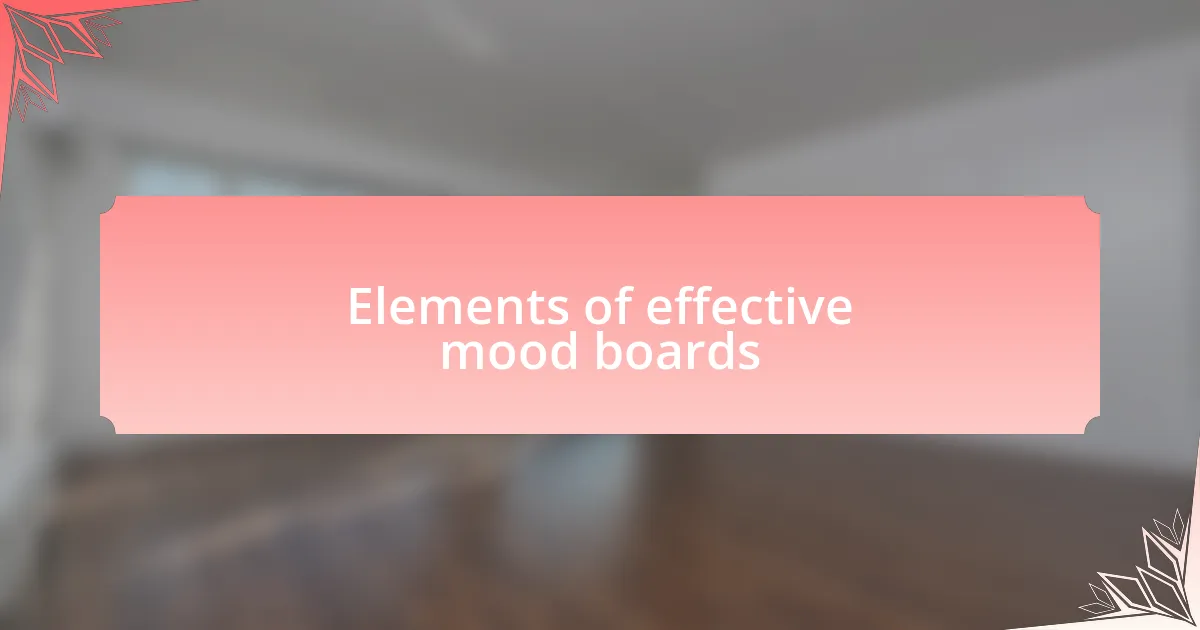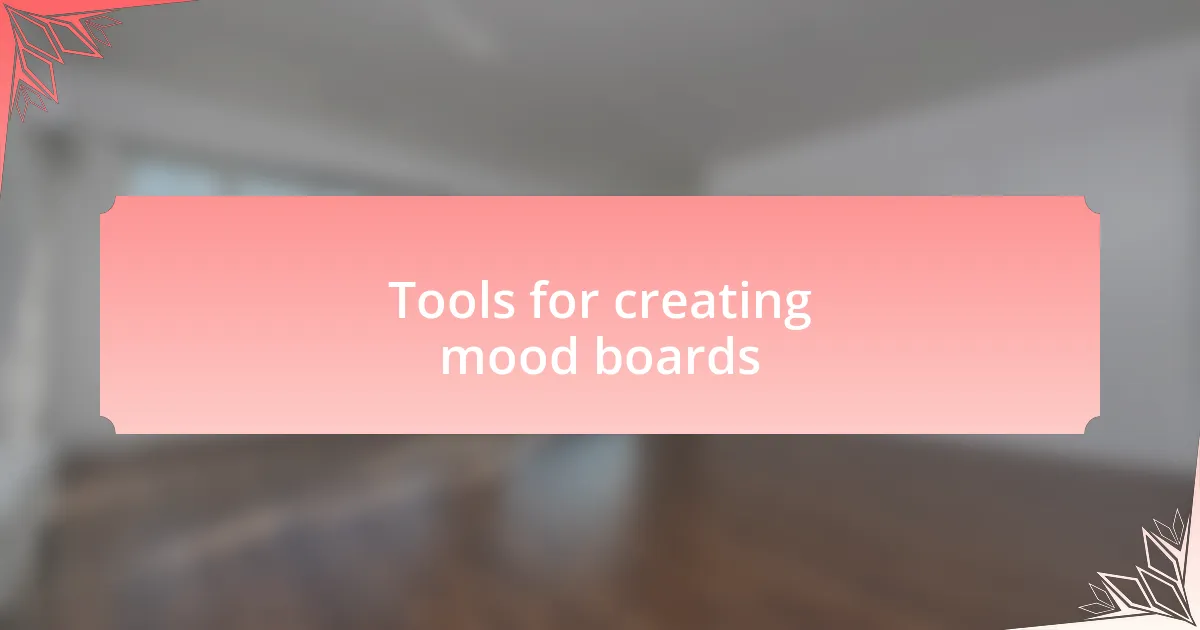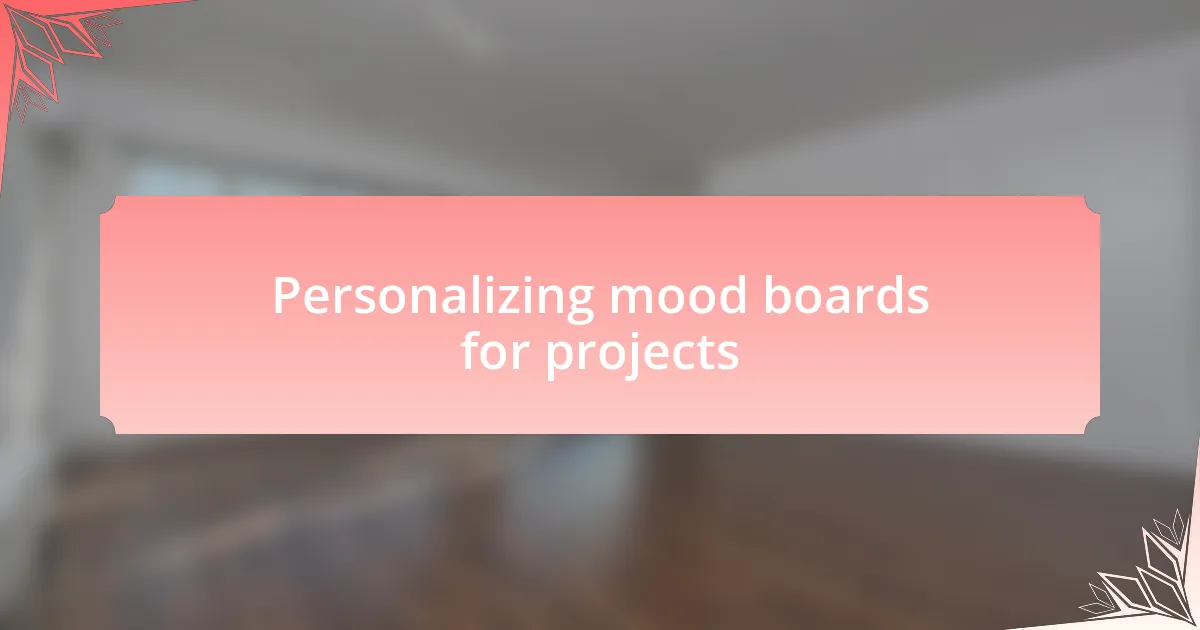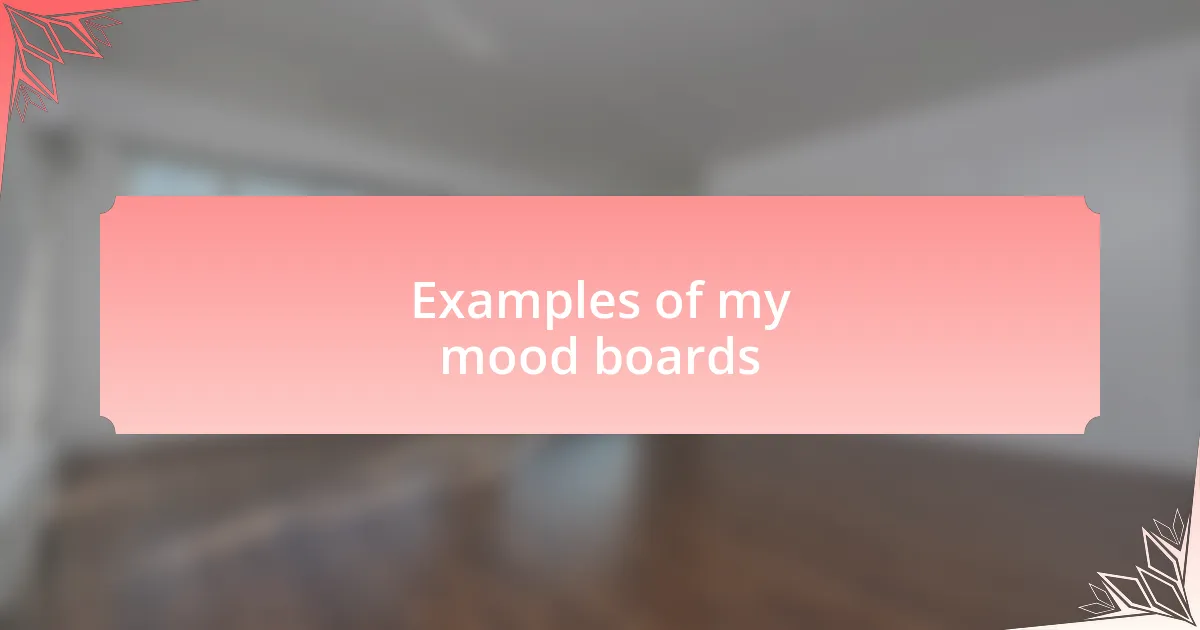Key takeaways:
- Mood boards serve as visual representations that capture concepts and emotions, facilitating collaboration and enhancing creativity among team members.
- Effective mood boards focus on clarity, diversity in imagery, and context; incorporating colors, textures, and relevant text to guide interpretation.
- Personalizing mood boards by including local elements and engaging stakeholders fosters a sense of ownership and community connection in projects.
- Utilizing both digital and physical tools can enrich the mood board creation process, leading to innovative ideas and effective communication.

Understanding mood boards
Mood boards are more than just a collection of images; they are a visual representation of concepts and feelings that guide the direction of a project. I remember the first time I created one for a community housing initiative, feeling overwhelmed yet excited as I pieced together colors, textures, and words that resonated with my vision. Isn’t it fascinating how a simple collage can capture the essence of what we aspire to create?
When assembling a mood board, I focus on elements that evoke emotions and tell a story. For instance, incorporating images of cozy communal spaces can spark ideas about fostering community connections. Have you ever looked at an image and felt an instant emotional pull? That’s the magic of mood boards—they translate feelings into a tangible format that can inspire both creators and stakeholders.
In my experience, a well-crafted mood board serves as a collaborative tool, enabling conversations around aesthetics and objectives among team members. I often encourage others to share their interpretations of the board, which can lead to unexpected insights and ideas. How often do we find that our initial thoughts evolve through dialogue? This interactive process not only enhances creativity but also reinforces a shared vision, making the final project more cohesive and meaningful.

Elements of effective mood boards
When creating an effective mood board, clarity is crucial. Each element should serve a purpose, whether it’s color palettes that evoke warmth or textures that suggest comfort. I once used a vibrant blue to represent tranquility in a community space, and it completely transformed the way stakeholders perceived the project’s goal. Have you ever noticed how certain colors can shift your mood in an instant?
Another essential element is diversity in imagery. A successful mood board often includes a mix of photographs, patterns, and materials that reflect various aspects of the envisioned space. For example, I like to add sketches alongside finished photographs to show different stages of thought process. It’s interesting to consider how combining different styles can inspire new ideas. What would happen if we included elements from different cultural perspectives?
Finally, context matters just as much as the visuals. Adding text or brief captions can clarify the intentions behind each element, guiding the viewer’s interpretation. I remember once labeling a section “community engagement” with images that depicted people interacting in shared spaces. This helped turn abstract concepts into relatable actions. Isn’t it intriguing how a few words can bridge gaps in understanding?

Tools for creating mood boards
Creating mood boards often relies on effective tools that facilitate visualization and organization. I find that digital platforms like Canva and Trello allow for easy arrangement of images and ideas, making it simple to see how different elements interact. Have you ever used a tool that just clicked for you? For me, dragging and dropping images onto a blank canvas feels incredibly liberating.
Physical tools can also play a significant role. When working with clients, I sometimes bring a selection of magazines and scissors, encouraging a tactile approach that sparks creativity. There’s something magical about cutting out images and arranging them by hand—have you ever felt the satisfaction of seeing your vision come together in real-time? It’s a process that fosters collaboration and inspires dialogue.
I’ve also explored applications like Pinterest, which is like an endless ocean of inspiration. There I can curate boards tailored specifically to each project, pulling in ideas from various sources and perspectives. It’s fascinating how the act of pinning images can ignite fresh conversations and lead to unexpected discoveries. How does an online aesthetic influence your understanding of space and community? I believe it can open up new avenues for thought that traditional methods might not capture.

Personalizing mood boards for projects
Personalizing mood boards for projects allows me to infuse my unique perspective into every aspect of a community housing development. I often start by gathering images, colors, and textures that resonate with the project’s vision. For instance, when working on a housing initiative aimed at fostering community engagement, I select images showcasing vibrant communal spaces, capturing the essence of togetherness. Don’t you think that aligning visuals with emotions can transform a project from mere plans into something truly inspiring?
Each mood board feels like a personal story waiting to unfold. I love incorporating elements that reflect the community’s character—local art, historical architecture, and nature. I remember one project where I included photographs taken by residents; their stories brought depth and authenticity to the board. Isn’t it interesting how adding a local touch can create a sense of ownership for the community? This connection not only personalizes the mood board but also makes the envisioned project feel truly representative of its future inhabitants.
In my experience, involving stakeholders in the mood board creation process enhances personalization significantly. During workshops, I invite participants to contribute their own images and ideas, sparking discussions that deepen the project’s relevance. The energy in the room shifts in those moments; it’s like everyone is layering their hopes and dreams into a shared vision. Have you ever seen how collaboration can breathe life into an idea? It’s a reminder that a mood board isn’t just a visual tool—it’s a canvas for collective aspiration.

Examples of my mood boards
When I look back at my mood boards, I often recall one project focused on sustainable housing. For that board, I meticulously chose earthy tones and textures that evoked the calming elements of nature. I included samples of reclaimed materials and greenery, aiming to portray not just a home, but an eco-conscious lifestyle. Isn’t it fascinating how color choices can evoke emotional responses that shape a project’s narrative?
In another instance, while developing a community center aimed at young families, I created a mood board that featured playful designs, soft pastels, and images of children playing in safe, inviting environments. These elements sparked conversations about the importance of safety and creativity, reminding us how essential it is to create spaces where children can thrive. I’ve always believed that incorporating such lively visuals can turn abstract ideas into relatable experiences. Have you ever thought about how a simple image can trigger memories and feelings connected to a space?
One of my favorite mood boards was for a senior community project, where I included warm, comforting color palettes and photographs of active seniors enjoying various activities. The intent was to highlight accessibility and vibrancy, rather than isolation. By showcasing local amenities and joyful interactions, I aimed to capture the essence of an engaged, lively community. It made me realize that even in the later stages of life, the right environment can promote a spirit of togetherness and vitality. What do you think that says about the importance of thoughtful design in every stage of life?